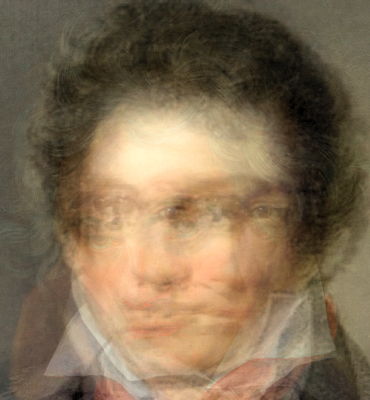 FEEDBACK: She said WHAT? Read what people think about our Classical Music Daily features, and have your say!
FEEDBACK: She said WHAT? Read what people think about our Classical Music Daily features, and have your say!
SIMULTANEOUS BEETHOVEN

ENDRE ANARU listens to all the
Beethoven symphonies simultaneously
In the nineteenth century, the great pianist Adolph von Henselt (considered the equal of Liszt), and obviously a musician of high quality, would turn and sit on the piano keyboard to demonstrate the first bar of the last movement of Beethoven's 9th Symphony. The chord bothered him a great deal, and that is what he thought it sounded like (a tone cluster - presumably played by wind instruments).
What then would he have said about this? :
EVERY BEETHOVEN SYMPHONY AT THE SAME TIME
[WARNING: the external link above is to youtube.com which may set cookies, track and profile you and display advertising. To avoid this, listen to the sample below.]
Listen — Opening of all Beethoven symphonies at the same time
(0:00-0:59) Compilation © 2017 Nathan Middleton :
The odd thing is that modern ears seem to adjust to the sound and accept it. Now, why would that be?
I suggest that it is because our modern soundscape is so complex, and made up of many different simultaneous sound sources, that we have grown accustomed to the complexity of sound, from which our ear/mind can tease information. This is certainly music that fits the modern urban acoustic environment. Think of the noise, the sounds, the ambient volume level, and how important sounds - 'signals', according to R Murray Schafer - come out of the soundscape and register on our awareness. The 'curtain of sound' is opened and we hear something important.

Nine portraits of Ludwig van Beethoven superimposed.
Compilation © 2019 Keith Bramich
I suggest too that this kind of music indicates that we are listening differently today: We hear swaths of sound. Complex aggregates. Waves. Not individual notes, but masses of sound.
You can hear similar sorts of sounds in much heavy metal music, though Phil Spector's 'Wall of Sound' is not far away. In classical music, think of the player piano scores of Conlon Nancarrow or the solo piano works (for super virtuosi only) by George Flynn. Some have suggested the sound of such music is like some of Ligeti's compositions in the 1960s. Think also of spectral music.
The musical roots of this sort of thing go far back - Thomas Tallis' Spem in alium is a Renaissance version. Some of Wagner's music is like this. A more modern example is Come Out (1966) by Steve Reich. (The effect is achieved slowly through to the conclusion.) Much music in the Black MIDI world is of this manner.
But, other art forms are also relevant.
In the finale of Doris Lessing sci-fi book The Making of the Representative of Planet 8, the frigid suffering of the entire planet's sentient life forms is undergone to create a giant hive mind and collocation. The individual (important only insofar as he/she belongs to a specific profession (!)) merges into the mass, like a drop of water in the sea. This is a fundamental notion of Sufism (which itself has influenced many modern schools of mysticism to one degree or another, though the notion is hardly specific to them, being found even in ancient Stoicism). I hesitate to comment on the ideas and notions of the Freemasons. And I speak not at all of Dianetics. But, I will say that modern mass media seeks to conscript the unimportant individual into consumerism, but also cults, movements, and 'catching the wave'. We are all made part of the Mass.
Intellectually, one can say this sort of music corresponds to the notions of psychohistory in Isaac Asimov's Foundation series of novels. It corresponds to notions of 'Big Data'. There are connections with issues of crowds and crowd behaviour that Elias Canetti spoke of in his book Crowds and Power, which itself drew on the nineteenth century book The Crowd (Psychologie des Foules) by Gustave Le Bon. It corresponds to our culture's mass scale of advertising, of sales, of media and of war.
In a word: The single is not of much importance, but the aggregation is. 'Avengers; Assemble!'
This gives important suggestions for composers, how to compose and what sort of music to write to appeal and reach modern listeners.
To give a synopsis for clarity's sake:
- Combine sounds into extremely large masses;
- Reuse material from older composers;
- Consider the process of crowds, the mass and the utter unimportance of the small portion which is USED to create the greater;
- Remember the whole is greater than the sum of its parts;
- OR: Do not follow the crowd and create music of simple structure and simple gesture. Glorify the individual. Remember Yourself.
Copyright © 28 August 2019
Endre Anaru,
Pendant d'Oreille, Canada



